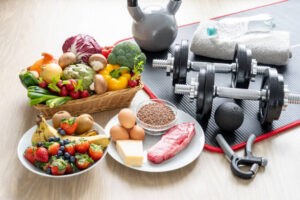Nutrition and Fitness

Tips and Tricks That Actually Work
Eat less, exercise more, drink lots of water, commit to a change in lifestyle. There’s probably not too much you haven’t heard or read from the experts when it comes to tips for losing weight. What those experts don’t always tell you, however, are ways to make these weight-loss basics easy to adopt into your everyday life. Here, nutritionists and weight-loss experts*, share what they’ve learned from years of experience. So pour yourself an 8-ounce glass of water and check out these secrets to sure-fire weight-loss success.
Chew cinnamon gum
The taste of cinnamon is more stimulating than fruit or mint flavors and will keep you satisfied longer, say flavor experts.
Factor 100 to 200 calories of “fluff” into your daily diet. Whether it’s a couple of Hershey kisses from the office candy dish or a few handfuls of a pal’s popcorn at the movies, it’s likely you’re taking in more calories than you’re aware of. Sometimes accounting for those extras can mean coming out on the winning end of the calories-in versus calories-burned equation—which is the key to weight loss.
Get creative with the foods you keep on hand for snacks. Let’s face it: You’re not going to be satisfied with carrot sticks and celery stalks when you’re craving something flavorful. Stock a large bowl with exotic fruits such as papayas, star fruits, mangoes and kiwifruits. They’re naturally sweet, packed with vitamins and high in fiber, which means they’ll leave you feeling full rather than focused on what you can eat next.
Don’t eat while you read, watch television, talk on the phone or work at your desk. You’ll end up focusing far more attention on the task at hand than on your enjoyment of the food. Inevitably you’ll end up eating much more than you realize, yet you won’t really have tasted any of it, which will leave you feeling unsatisfied. And feeling unsatisfied is the surest route to the start of a binge.
At a restaurant, order a salad as an appetizer and an appetizer as a main course. Many restaurant entrées contain way more than a single portion anyway, so by ordering a smaller portion, you put yourself in control of how much will be on your plate. If none of the appetizers on the menu strike your fancy, most restaurants are happy to serve you an appetizer-size portion of a pasta entrée upon request.
After you come home from work, wait 20 minutes before going into your kitchen. This helps you to avoid impulse eating brought on by stress.

Store leftovers in individual containers instead of one big one. When it’s time for your next meal, you’ll have a single-serving portion ready to go. Psychologically, this can go a long way toward preventing you from overeating.
Schedule snacks for every two hours, and plan what you’re going to snack on. Building this component into a diet plan will allow you to eat between meals without feeling that you’re doing something counterproductive to your plan. Plus, keeping a steady supply of nutritious foods in your stomach throughout the day is likely to prevent you from becoming so hungry that you overeat at meals.
Replace high-fat cooking staples, such as butter and oil, with low-fat chicken, beef or vegetable broth. When you sauté vegetables, whip up some instant mashed potatoes or make a sauce. You’ll be surprised how much flavor broth can add to a recipe, and you won’t miss the fat.
If you’re planning a hike or family outing, ditch the traditional gorp (which contains lots of fat and sugar) As an alternative, use wholesome homemade trail mix made with whole-grain cereal, dried fruits and a few nuts sprinkled in for protein